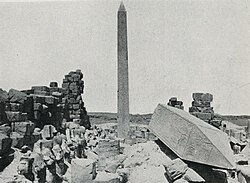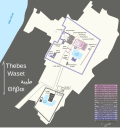Karnak
Karnak is the largest ancient religious site in the world. The complex of temples is near Luxor on the Nile in Egypt. Luxor is some 500 km south of Cairo. About thirty pharaohs contributed to the buildings. The site reached a size, complexity, and diversity not seen elsewhere.
The Karnak Temple Complex—usually called Karnak—is a vast group of ruined temples, chapels, pylons, and other buildings. The largest and most important are the Great Temple of Amun, and a massive structure begun by Pharaoh Ramses II (ca. 1391–1351 BC).
An ancient sacred lake is part of the site as well. The area around Karnak was the ancient Egyptian Ipet-isut ('The Most Selected of Places'). It was the main place of worship of the eighteenth dynasty, part of the monumental city of Thebes.
Precinct of Amun-Re
This is the largest precinct of the temple complex, dedicated to Amun-Re (a form of Amun), the chief deity. There are several colossal statues including the figure of Pinedjem I which is 10.5 meters tall. The sandstone for this temple, including all the columns, was transported from Gebel Silsila 100 miles south on the Nile river.[1] It also has one of the largest obelisks weighing 328 tonnes and standing 29 meters tall.[2][3]
The Great Hypostyle Hall
The Great Hypostyle Hall of Karnak, within the Karnak temple complex, in the Precinct of Amun-Re, is one of the most visited monuments of Ancient Egypt.
The hall covers an area of 50,000 sq ft (5,000 m2). The roof, now fallen, was supported by 134 columns in 16 rows; the 2 middle rows are higher than the others (being 33 feet (10 m) in circumference and 80 feet (24 m) high).
The hall was not begun by Horemheb, or Amenhotep III as earlier scholars had thought. It was built entirely by Seti I who covered the northern wing of the hall with inscriptions. Decoration of the southern wing was completed by Ramesses II. Ramesses changed Seti's names to his own along the main east-west axis of the Hall and part of the north-south processional route.
The three closed sites
The precinct of Amun-Re is the only part of Karnak which is open to the public. There are also three smaller precincts, which are not open:
- Precinct of Mut. This was dedicated to the mother goddess, Mut, who was worshipped as the wife of Amun-Re. It has several smaller temples and its own sacred lake, in a crescent shape. This temple has been ravaged, many portions having been used in other structures. It is not open to the public. Six hundred black granite statues were found in the courtyard to her temple. It may be the oldest portion of the site.
- Precinct of Montu. This portion of the site is dedicated to the son of Mut and Amun-Re, Montu, the war-god. It is to the north of the Amun-Re complex, and is much smaller in size. It is not open to the public.
- Temple of Akhenaten (Amenhotep IV). This was destroyed after the death of its builder. Akhenaten attempted to overcome the powerful priesthood that had gained control over Egypt before his reign. The priesthood of that temple regained its power as soon as he died and destroyed many records of his life. The temple was so well demolished that its full extent and lay-out is unknown.
Karnak Media
The Great Hypostyle Hall (1857, Rijksmuseum, The Netherlands)
Hieroglyphs from the great obelisk of Karnak, transcribed by Ippolito Rosellini in 1828
The Precinct of Amun-Re as seen from the Sacred Lake
Map of the Precinct of Mut and Amun-Re












